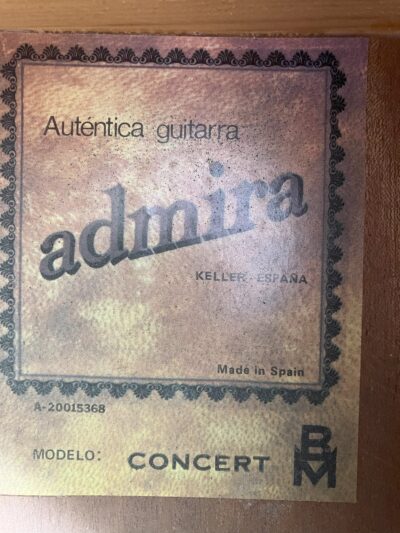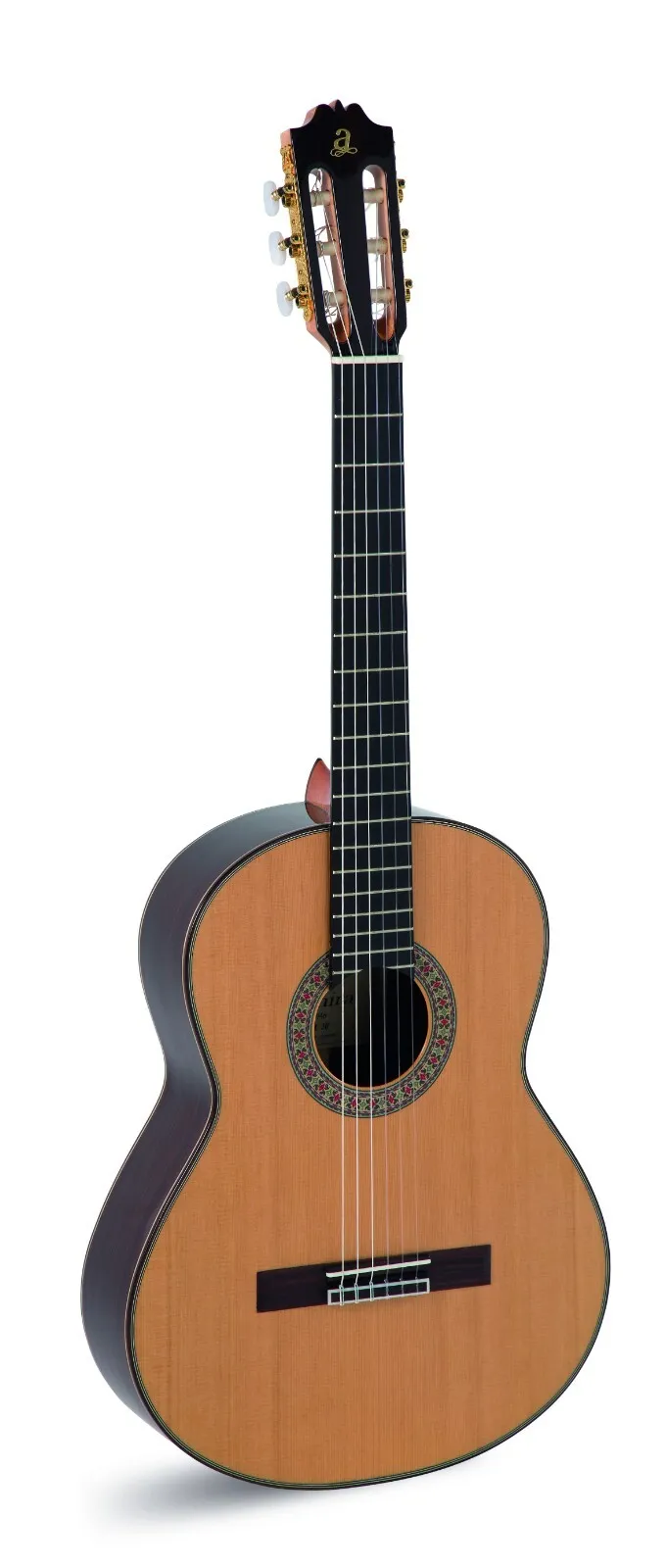
He looked at me and said “You’re using harmonics?” I nodded. “I never thought of that. I’ve had it a few years and still can’t play. Take it, it’s yours”. That’s how I came to have a classical guitar that’s been in my possession for the last 30 odd years. It was an Admira and I found out a bit later that it would have cost him around £300.
Recently I had the opportunity to play the latest model in that series and was excited to see if it had changed in anyway or had the same quality as mine
If we start with the construction of mine, it’s made with the following materials
- Top: Solid Cedar with a Satin finish.
- Sides and Back: Rosewood with a Satin finish. Some listings mention Ovangkol, which is very similar to Rosewood in its tonal properties.
- Neck: African Mahogany.
- Fretboard: Mahogany.
- Bridge: Mahogany.
- Machine Heads: Nickel Lyre.
These materials are chosen for their durability and contribution to the guitar’s tone and resonance. The combination of solid cedar and rosewood or ovangkol is typical for classical guitars, providing a warm, rich sound with ample volume and clarity. And 30 years later that’s still the case. It’s a beautiful instrument to play.
But how does it compare to the A20 latest version?
Well the construction materials are almost identical. The only difference is the newer model has an ebony fretboard and the whole thing costs more more than 4 times as much as the 1980s model at £1,290 on Amazon. That’s probably a great bargain considering how prices have risen in 30 years (a 50p pint of beer will now cost you £5.70). The sound though, well seriously it’s well named. You could pay £4,000 or more for a similar sounding guitar. It’s a joy to play. Your fingers just seem to find the right frets as if by magic, the tone can only be described as amazing and when you need to move your left hand rapidly from 1st to 3rd position your thumb slides up the neck as if it were oiled but never feels slippery. When you stop you feel secure in whatever position on the neck you happen to be. Harmonics just ring out loud and clear.
If you want an instrument for fairly frequent performances but you don’t get paid top whack (yet), well this one will be a good investment.
But what if you don’t have a spare £1,300 lying around or maybe you’re just starting out in classical guitar playing? Well first lets look a little at the company and ethos.
Admira guitars are crafted with a blend of traditional Spanish guitar-making techniques and modern manufacturing systems. The process involves:The manufacturing workshops are based in Zarautz, northern Spain, where the guitars are produced to maintain the highest quality. The dedication to craftsmanship at Admira ensures that each guitar upholds the rich tradition of Spanish guitar making while incorporating modern elements for today’s musicians.
- Selecting Woods: Admira guitars often use solid cedar for the top and Indian rosewood or mahogany for the back and sides, which are known for their tonal qualities and durability.
- Handcrafting: While some processes are automated, the vast majority of each guitar is built and finished by hand by skilled craftsmen and women.
- Neck Construction: The neck is typically made of mahogany with rosewood reinforcement, enhancing the instrument’s sturdiness and attractiveness.
- Bridge: A rosewood bridge is used, aiding resonance, intonation, and tone.
- Spanish Heel: The ARTESANÍA series, for example, is made with the union between the body and the neck of the guitar through the Spanish heel, a traditional method of construction.
The manufacturing workshops are based in Zarautz, northern Spain, where the guitars are produced to maintain the highest quality. The dedication to craftsmanship at Admira ensures that each guitar upholds the rich tradition of Spanish guitar making while incorporating modern elements for today’s musicians.
This applies pretty much to every guitar they make, no matter what the cost and they start at £123 for a full size guitar. It’s the Alba Student guitar. In this case, though, the word Student doesn’t apply to the musician but to the craftsperson who made it, under supervision of one of Admiras’ master luthiers. A rosewood back, sapele sides, pine top, mahogany neck means it[‘s suitable for a beginner
Next up is the Malaga, made from spruce, mahogany and rosewood. This is a solid top guitar and you will be very hard pressed to find one of this quality and craftsmanship for £258. You’d probably get one of these, or the Concerto, when going for your grade 4 exams.
Of course you could splash out a bit more and get the Concerto model. A cedar top and rosewood back. cedar body and mahogany neck give this guitar one of the best sounds at this price . £279
But now we’re going to skip a few models and head to the £400 mark (£402 on the day of writing) with the A4. This instrument has a mahogany back and sides with a cedar top, mahogany with ebony reinforcements for the neck and kabakulli for the fretboard. `The neck joint is with the Spanish Heel technique, considered the most highly developed technique for this area. At this price range you’re getting serious about your guitar playing and this is an instrument that will back you all the way. an excellent sound. You just won’t get a much better guitar at this price. You’re also unlikely to get one that’s all solid wood, and it will last.
Our last look on this visit was at the A45. This model is part of Admira’s ARTESANÍA series, which is crafted by skilled luthiers using traditional handcrafting methods to produce guitars with exceptional tone, clarity, and expression. This series represents the crown jewel of Admira’s offerings, blending top-quality materials with passionate craftsmanship. You can guess that just as the materials are superior, so is the tone and the sheer playability of this guitar. If you’re doing your B. Mus. and focussing on classical guitar this model would be up there on my list of ones to buy. £649 at the time of writing
Disclaimer: Admira didn’t pay us, or ask us to write this review. We just happen to be very impressed by their guitars. But if you do buy from Amazon we’ll get a small commission.

